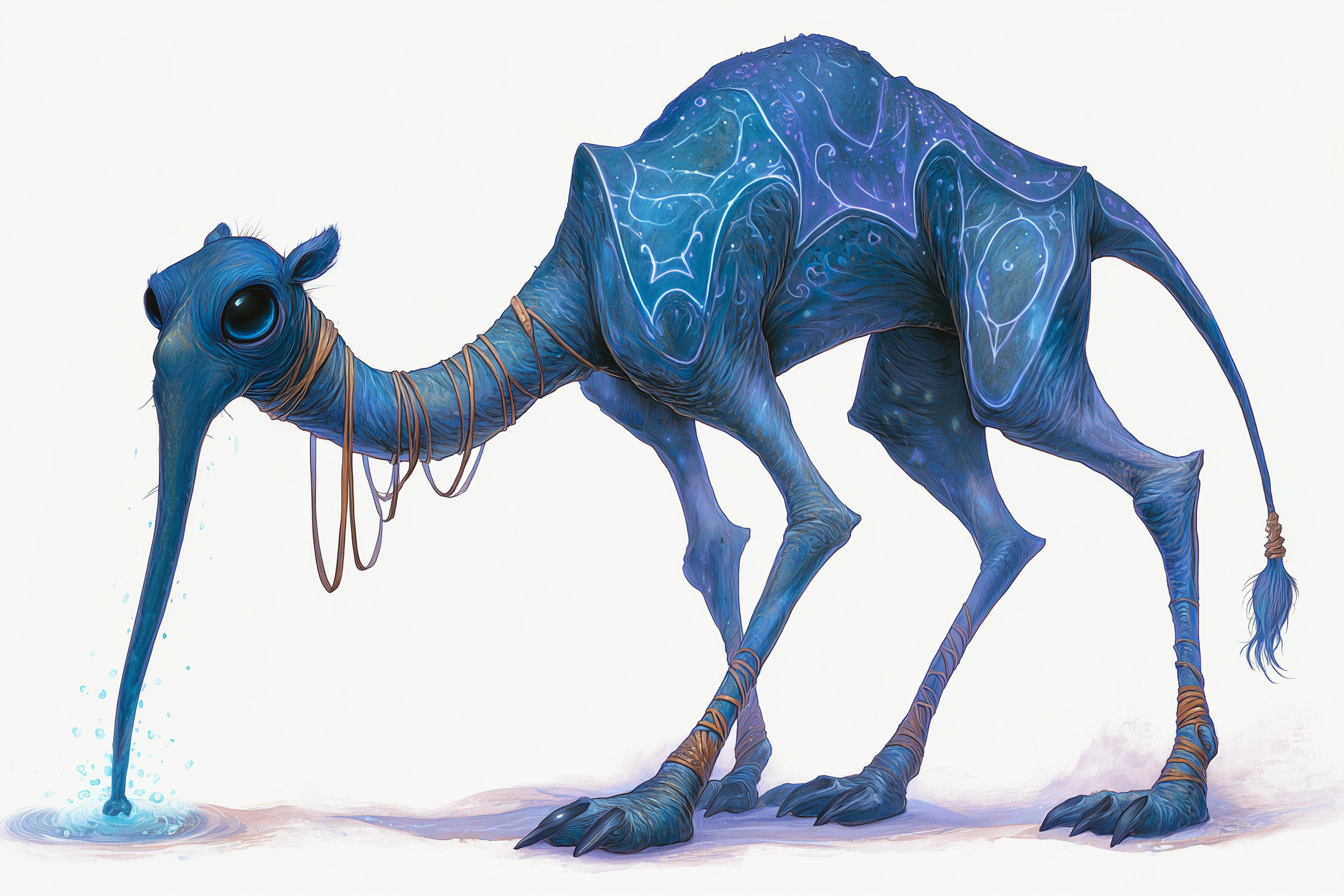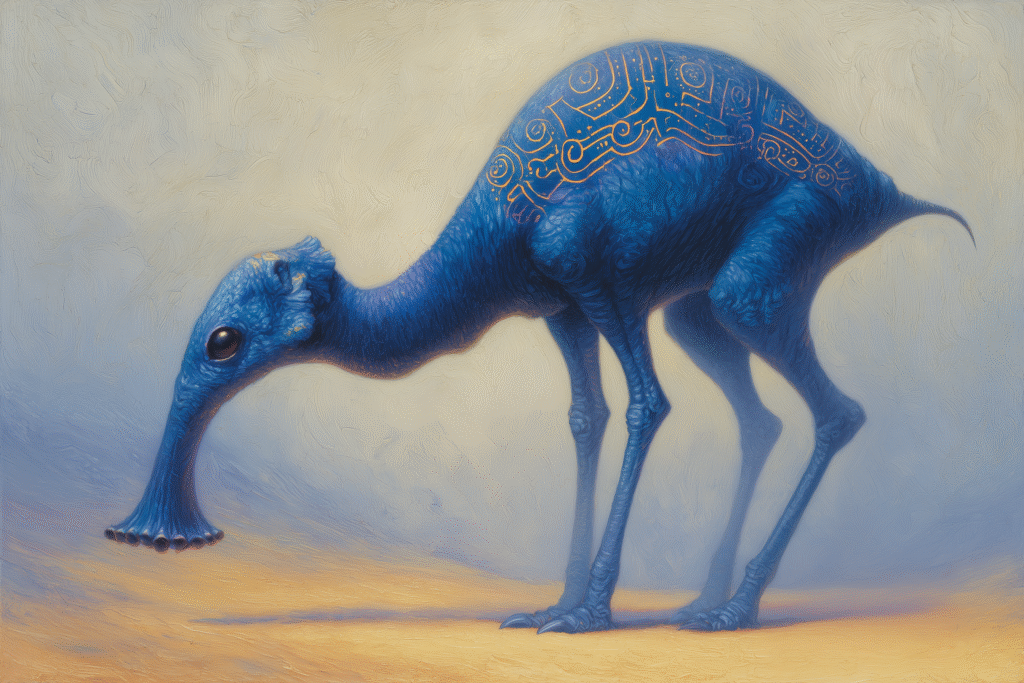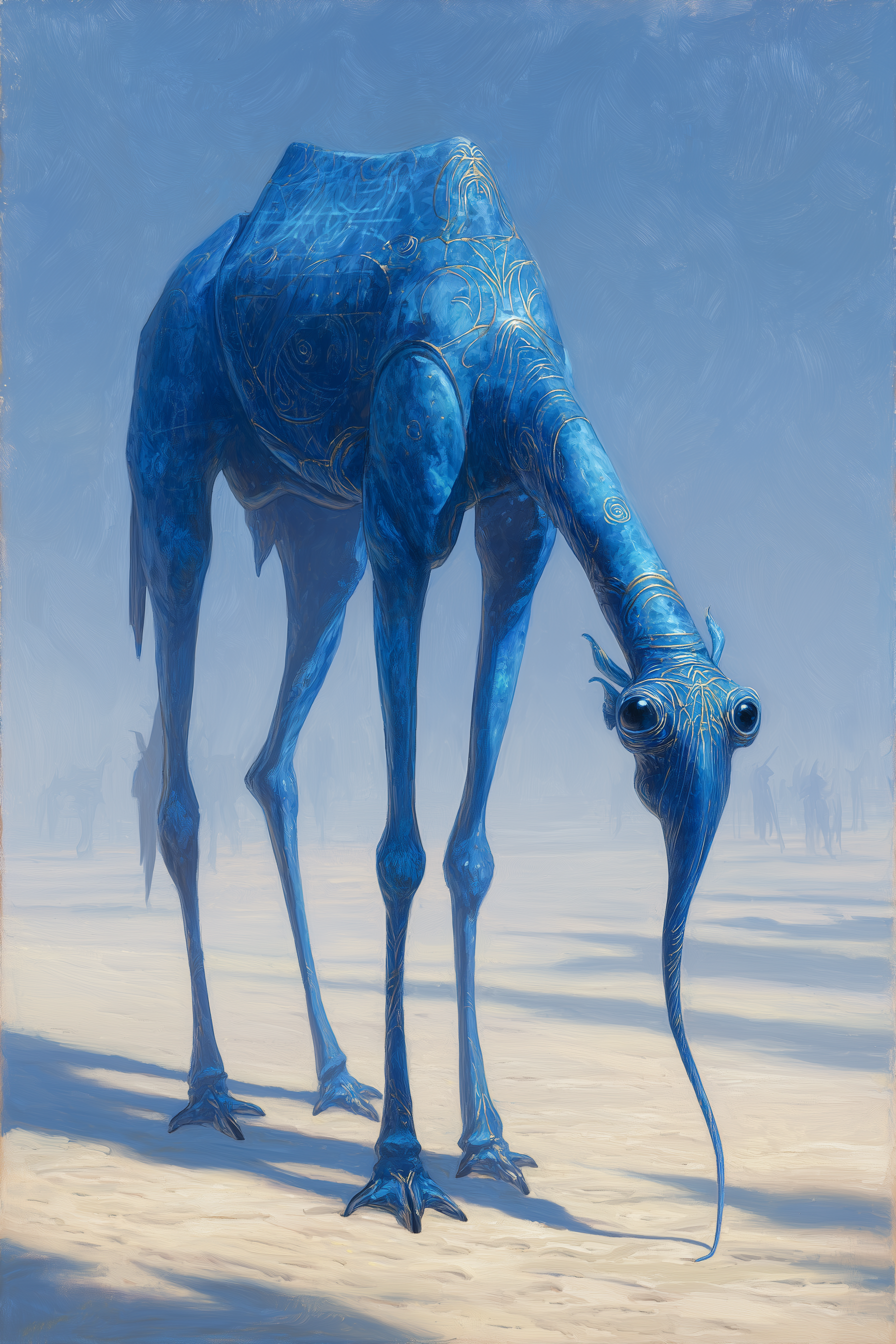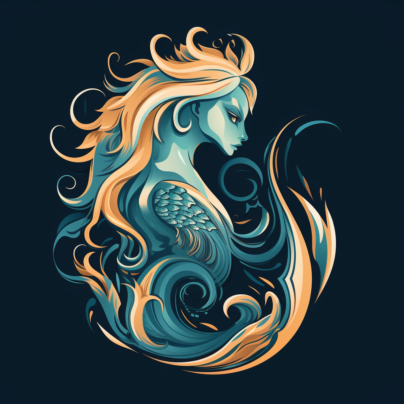Disenchanter, Scourge of the Arcane
“It looks like a blue camel—until the disenchanter sniffs out your magic sword and slurps it into oblivion.”

The Disenchanter resembles a sleek, blue-furred camel with a single pronounced hump and long, stilt-like legs ending in splayed, gripping toes. Its prehensile trunk, constantly in motion, ends in a fluted, bell-shaped tip capable of suctioning onto objects and draining them of magical energy. Its skin shimmers faintly, as though wrapped in a haze of untamed arcane essence. The creature’s expressive ears and mournful eyes give it a strangely innocent air—until it begins to feed.
Behavior
Gentle by nature, the Disenchanter is not a predator of flesh but of enchantment. It is intelligent, curious, and deeply social, seeking the company of both its own kind and other intelligent beings. It shows signs of rudimentary empathy and communication, especially with creatures that treat it kindly. However, it is also compulsively drawn to strong sources of magic and will abandon companionship without hesitation to pursue them. Once engaged in feeding, it becomes singularly focused, unresponsive to commands or distractions until it has drained its prize.
Habitat
They can be found in nearly any environment, from open plains to dungeons, forests, or mountain passes. They follow the scent of magic across vast distances and have been known to appear in places they were never seen before—slipping through planar seams or stepping seemingly from thin air. Though they prefer temperate climates, their need for arcane sustenance far outweighs environmental concerns.
Modus Operandi
They detect magic at great distances and approach silently, often with a strange, graceful gait that seems to defy terrain and distance. Upon locating a magical item, they latch on with their trunk and begin the draining process, which renders most items mundane within seconds. If prevented from reaching its target, the Disenchanter becomes agitated and may lash out with bursts of raw magical force. It avoids cursed items instinctively, and will often test headgear by placing it upon its own head before deciding to devour it or discard it.
Motivation
The Disenchanter hungers for magic not out of malice, but biological necessity. Its hump stores magical energy, allowing it to survive for days or weeks without feeding. Even when sated, it will continue to seek enchantment compulsively, expelling excess energy as radiant mist or bursts of chaotic force. It is also driven by a need for companionship and, when not actively feeding, may act as a loyal beast of burden, mount, or even protector—so long as it is treated well and magical temptation is kept at bay.
Disenchanter 5e
Disenchanter, Pathfinder
Disenchanter

Large Magical Beast, Neutral
Challenge 6 (2,300 XP) • Proficiency Bonus +3
Armor Class 15 (natural armor)
Hit Points 105 (14d10 + 28)
Speed 40 ft.
| STR | DEX | CON | INT | WIS | CHA |
|---|---|---|---|---|---|
| 18 (+4) | 14 (+2) | 15 (+2) | 6 (−2) | 16 (+3) | 10 (+0) |
Saving Throws Wis +6, Dex +5
Skills Perception +6, Insight +5, Survival +6
Senses Darkvision 60 ft., Passive Perception 16
Languages Understands Common and Sylvan, but cannot speak
Proficiency Bonus +3
Traits
Magic Sense. It can detect the presence of magic within 300 feet. It instinctively knows the direction and approximate strength of the nearest magical item or effect, even if it is invisible or hidden.
Magic Eater. The disenchanter feeds on magical energy. When it uses Drain Magic, it stores the absorbed power in its hump as up to 3 charges. While it has at least 1 charge, its Aura of Disruption is active.
Aura of Disruption (While Charged). While the disenchanter has at least 1 stored charge, it exerts a 20-foot radius antimagic field:
- Creatures have disadvantage on Constitution checks made to maintain concentration.
- Any spell cast within the aura must succeed on a DC 15 spellcasting ability check or fail and expend the slot.
- Ongoing magical effects (such as invisibility or detect magic) are suppressed while in the aura.
Innate Empathy. It has advantage on Wisdom (Insight) checks to sense emotions. It can form emotional bonds with nonmagical humanoids or beasts and may follow or protect them.
Magic Resistance. It has advantage on saving throws against spells and magical effects.
Actions
Multiattack. The disenchanter makes two Trunk Lash attacks, or one Trunk Lash and one Drain Magic if a valid target is in reach.
Trunk Lash. Melee Weapon Attack: +7 to hit, reach 10 ft., one target.
Hit: 13 (2d8 + 4) bludgeoning damage.
Drain Magic (Recharge 5–6). The disenchanter suctions its trunk onto a creature or magical item within 5 feet.
- Against a creature: The target must succeed on a DC 15 Constitution saving throw or lose one active spell effect (GM’s choice), or have one worn/held magic item suppressed for 1 minute. The disenchanter gains 1 charge.
- Against an unattended magic item: The item is rendered mundane for 1 hour. The disenchanter gains 1 charge.
- Very rare or rarer items require a DC 15 Charisma saving throw (by the item or wielder) to resist being drained.
Arcane Sputter (Costs 1 charge). The disenchanter releases a 20-foot cone of unstable arcane energy. Each creature in the area must make a DC 15 Dexterity saving throw, taking 21 (6d6) force damage on a failure, or half as much on a success. This damage bypasses resistance but not immunity.
Reactions
Spell Feedback (1/Day). When targeted by a spell, the disenchanter may use its reaction to attempt to absorb it. The caster must make a DC 15 spellcasting ability check. On a failure, the spell is negated and the disenchanter gains 1 charge.
Tactics
Disenchanters prioritize magical targets. They open combat with Drain Magic on a key item or spell effect. Once charged, they rely on Aura of Disruption to suppress spellcasters. If surrounded or injured, they use Arcane Sputter to disengage. They are easily distracted by unattended magical items and will rarely risk injury if they sense easier sources nearby.
Treasure
Disenchanters do not hoard treasure. However, they are sometimes found wearing magical headgear that they favor. The fat from a well-fed disenchanter’s hump can be harvested (within 48 hours of death) and sold for up to 500 gp as an arcane reagent. More often, the creature’s true value lies in its abilities.
A tamed disenchanter may serve as a living dowsing rod, a mount, or even provide temporary enchantments to weapons (similar to magic weapon) using stored charges. Though they do not wield weapons themselves, their actions suggest a deeper, intuitive understanding of magic.
Disenchanter

This blue-furred creature sports an elephantine trunk and a camel-like body. The air around it seems to shimmer with magical potential, and it gazes around with doe-like, intelligent eyes.
Disenchanter CR 3
XP 800
N Large magical beast
Init +3; Senses darkvision 60 ft., detect magic, low-light vision; Perception +9
DEFENSE
AC 15, touch 12, flat-footed 12 (+3 Dex, +3 natural, -1 size)
hp 30 (4d10+8)
Fort +6, Ref +7, Will +4
DR 5/magic
Weaknesses vulnerable to dispel magic
OFFENSE
Speed 50 ft.
Melee trunk +7 touch (disenchant), 2 hooves +2 (1d6+2)
Space 10 ft.; Reach 5 ft. (10 ft. with trunk)
Special Attacks power spray
Spell-Like Abilities (CL 4th; concentration +3)
Constant—detect magic
3/day—magic weapon
1/day—dimension door
STATISTICS
Str 19, Dex 17, Con 14, Int 5, Wis 12, Cha 8
Base Atk +4; CMB +9; CMD 22 (26 vs. trip)
Feats Iron Will, Skill Focus (Perception)
Skills Escape Artist +5, Perception +9
Languages none
SPECIAL ABILITIES
Disenchant (Ex)
A disenchanter can use its trunk to make a melee touch attack against a target’s worn, held, or carried magic item in an attempt to drink the item’s magic. The disenchanter makes a caster level check (+4) opposed by the target’s Fortitude save. I
f the check succeeds, it drains the item’s magic, rendering it nonmagical. To determine which of a target’s magic items is affected, use Table 9-2 on page 216 of the Core Rulebook (though a disenchanter never uses this ability on a headband or similar head-slot item unless it has first tried to wear the item). Disenchanters may instead target specific visible items, in which case they generally target the most obvious items. Artifacts are immune to this ability. Disenchant only works against objects that a disenchanter can touch, and even a thin layer of cloth effectively protects items from it.
Power Spray (Su)
Once per day, it can release a 20-foot cone-shaped burst of raw magical energy through its trunk. Creatures in the cone take 4d6 points of damage (DC 14 Reflex save for half). Creatures immune to magic effects that allow spell resistance (such as golems) are immune to this ability. The save DC is Constitution-based.
Vulnerable to Dispel Magic (Ex)
A disenchanter targeted by dispel magic takes 1d6 points of damage per caster level (maximum 10d6, Fortitude save for half). Greater dispel magic functions similarly (maximum 20d6 damage, Fortitude save for half).
ECOLOGY
Environment warm land
Organization solitary, pair, or family (2 adults and 1-2 calves with the young creature template)
Treasure none
It is a blue-furred animal that resembles a single-humped camel with a prehensile trunk. It can sense magic, which it consumes for sustenance. When it finds a magic item, it suctions on with its trunk and drains the item of power in a few seconds, storing this power in its hump.
Disenchanters are social creatures, and often seek the companionship of other intelligent beings, making excellent mounts and trackers for treasure-hunters.
A typically they are feet long and weighs 1,600 pounds.
Additional Ecology
The disenchanter is a blue-furred animal that resembles a single-humped camel with a prehensile trunk. It can sense magic, which it consumes for sustenance. When it finds a magic item, it suctions on with its trunk and drains the item of power in a few seconds, storing this power in its hump.
Disenchanters are social creatures, and often seek the companionship of other intelligent beings, making excellent mounts and trackers for treasure-hunters.
Magic is a cornerstone of adventuring. Without it, the most powerful wizard is just an old man with a walking stick, and not even the most confident fighter turns down a magical weapon unless she has to. While few explorers and soldiers begin their careers with any great stores of magic, as they grow in notoriety, they tend to acquire more and more magical items, eventually coming to rely on them as much as they do on their mundane tools or their own abilities.
Thus it is that a gentle creature like the disenchanter is one of adventurers’ most feared opponents. Though not malicious, it constantly hungers for, and draws its sustenance from, the very magical power that gives most adventurers their edge.
The presence of a disenchanter instantly changes the nature of a battle, often forcing travelers to drastically change their tactics, relying solely on their wits and the strength of their arms.
It should be emphasized that the disenchanter means no harm, yet it may be precisely its oblivious nature that makes it such a threat. A disenchanter is a social animal that seeks out the company of others, even members of other species.
So long as those others do not possess magic to tempt its hunger, it’s often content to travel with humanoids as docilely as a half-domesticated horse or camel, and can even be encouraged to guard them at night. If it is treated well, a disenchanter may remain with travelers for long stretches, seeking both their goodwill and whatever scraps of magical essence they might feed it.
This camaraderie, however, inevitably ends as soon as it senses stronger magics, at which point it gallops away to seek out and devour the source of the magical emanations.
Standing more than 6 feet tall and 8 feet long, and weighing approximately 1,600 pounds, it is a gangly, knobby creature, with broad, flat feet capable of supporting its weight across a variety of terrain types. Its toes are splayed with retractable nails, allowing it to grip surfaces that might otherwise be a challenging climb.
When at rest, the disenchanter looks like it would trip over its own blue-skinned and furry legs if it tried to move too fast, but appearances can be deceptive. When it runs, the thin and slightly translucent disenchanter moves with a sudden grace, the soft beats of its footfalls not quite matching up with the rhythm of its moving legs—almost as if it were shifting magically through the intervening space, and its churning feet were merely a formality.
It’s body resembles that of a blue-furred camel, with a hump, a shaggy pelt, and a coarse mane that extends the length of its spine. Its strange skull sports a pair of expressive, camel-like ears, but its most striking feature is its prehensile trunk, which is constantly in motion and whose bell-shaped end is able to suction onto things or bend at numerous places to grasp and manipulate objects.
Like an elephant, it uses this trunk to sniff the air and handle items; it also uses its trunk to draw sustenance into its body.
All disenchanters exude a strong aura of magic, though this magic is unformed and holds no hint of a particular school. To those sensitive to magic, the air about a disenchanter shimmers and twists, as if it contained raw, chaotic power that it could shape at a moment’s notice.
For the most part, however, disenchanters do little to harness the power they absorb for sustenance, though some theorize that their aura may represent latent abilities that disenchanters have forgotten how to use—or is simply a lure designed to attract other beings with strong magic, thus helping it hunt.
Ecology
Though the specifics of the parties involved change from region to region, and depending on the speaker, most sages and biologists agree that disenchanters are a created race, given life and sentience by a wizard or cabal of immense arcane power.
A common thread in most of the legends dealing with disenchanters is that the beasts were created first and foremost as a magical weapon with which one nation could wreak mayhem on the magically empowered army of another.
The fact that this theme repeats so often, and in nations whose local mythologies otherwise have little to do with each other, does much to reinforce its feeling of truth. In fact, it’s possible that the basic idea may have been perpetuated by the racial sense-memories of the disenchanters themselves.
Disenchanters often seem to come from nowhere, stepping through walls and from behind trees, hunting magic. They go where the magic leads them—and when the magic has utterly gone from a swath of territory, they move on, often following the trail of a wizard or some other source of magical power.
Disenchanters deprived of magic rarely starve to death; instead, they simply disappear, folding back space and walking through to places unknown—other realities, perhaps, or secret places behind the worlds.
Whether or not the disenchanters know where they’re going when this happens is unknown, as few humanoids can manage any real communication with the creatures, and so far no one has come forward with a well-supported theory.
Despite their physical resemblance to camels, disenchanters do not appear to have more than a passing affinity for desert terrain. In fact, they can be found in all sorts of environments, even underground.
They do not den or establish lairs, preferring instead to roam freely in their search for food. As with any creature’s relation to its food source, they are more common where magic is more common or naturally occurring, and less so where magic is scarce.
Yet even in the most magic-rich environments, a disenchanter is a fortunately rare sight.
Clever adventurers and other intelligent creatures sometimes use the disenchanter’s deep desire to remain near magical sources to hunt for treasure troves and other such magical hoards. The general wisdom among those familiar with such creatures is that if there’s a disenchanter in the area, the location probably warrants a thorough investigation.
When their food disappears, disenchanters must go hunting, and in some places, magic proves rare indeed. Thus, like camels, disenchanters have evolved a food supply they can carry with them, from which they can draw sustenance in times of hunger.
That source is the disenchanter’s hump—once full, this hump can sustain the animal for nearly two weeks before it must feed again.
The hump is composed of magically infused and concentrated fat; when the disenchanter is forced to rely upon it, the hump shrinks until it becomes little more than a fold of loose skin atop the creature’s back.
Though exact estimates are difficult, given that disenchanters tend to disappear when deprived of food, most experts agree that even one minor magic item per week is enough to sustain a disenchanter—though not without significantly depleting its hump.
Still, all disenchanters act under a constant compulsion to eat beyond their capacity. They merely exude the extra power they take in as part of their hazy magical aura, or spray it at enemies in a devastating blast of raw power.
It is a rare disenchanter that can hoard or ration magical items, even knowing that it may be about to face famine.
Cursed items are poisonous to disenchanters, and they will avoid such foods even if starving. The only sort of normal magical items the disenchanter does not instinctively devour is headgear.
Before the disenchanter begins to eat, it first places any headgear it finds atop its own head and waits expectantly. Upon rare occasions, the item’s effect is pleasing to the creature (often inexplicably so), and it continues to wear it.
More often, it waits for a few seconds and then flings the item to the ground in apparent anger, draining it into uselessness.
To protect one’s treasures from a disenchanter, the first step is to secure them someplace where it’s difficult for the creature to reach them.
Simply hiding them within a tightly closed backpack, for instance, is sufficient to stymie the animal for a time, as the disenchanter’s power drain ability cannot reach through thick fabric.
Even tying magic items into a blanket with a complex and thorough knot is an effective defense for a time.
Unfortunately for a disenchanter’s targets, however, the creature’s prehensile trunk can lift more than 200 pounds, and the beasts have been known to move protected hoards to their own safe places, where they can try to outguess and undo knots and locks at their leisure.
As with a rust monster, the simplest way to escape a disenchanter with one’s items intact is to drop a weak or less valuable item, then move quickly to get more powerful items out of the disenchanter’s sensory range.
Few creatures want to fight for food when there’s an easier meal available, and the disenchanter is no exception.
In general, disenchanters remain largely unmolested by natural predators. While monstrous predators may occasionally target the creatures, they tend to do so only in the absence of other choices.
Those who have tried disenchanter meat report that it is gamey, powerful, and seems to rot on the tongue. Though some intelligent creatures eat this flesh out of the belief that doing so will impart some measure of the beast’s magical properties—or simply refuse to see the intelligent quadrupeds as anything more than herd animals—most societies that interact with the gentle disenchanters understand the fundamental innocence of the beasts and abhor such killings.
More often, disenchanters are slain as a result of a frantic humanoid’s attempt to defend his property. Casting dispel magic on a disenchanter harms it and depletes its hump by a week’s worth of food, enraging it to the point of attempting to murder the spellcaster responsible.
Though theoretically as intelligent as a human child, disenchanters have no spoken language or obvious desires outside food and companionship, and hence are often treated as mere beasts by intelligent humanoids.
While the disenchanters can use their trunks to make noises—fierce trumpetings or mournful hoots—their actual language is one of empathy and shared sensory perception.
When two disenchanters wish to share an idea, they place their strange snouts next to each other and puff out a tiny, iridescent cloud of magic that induces a type of synesthesia, transmitting a sensory memory of a smell, color, or feeling.
Sometimes these are literal—the scent of an enemy, or a feeling of warmth and comfort—and other times they’re more abstract, such as a vague impression of heat to represent the army that sweeps over a plain like wildfire.
To disenchanters, the nuances of such momentary visions are immediately clear. But members of other races who receive such a hallucinatory message often report feelings of confusion and nausea, though children have a much easier time understanding the creatures than adults.
Outside of their strange scent language, disenchanters can also rub their humps against trees, rocks, or other large objects, leaving a faint magical aura recognizable to other disenchanters.
Habitat & Society
Disenchanters are inherently social creatures, yet their need to feed on magic—a relatively scarce resource—means that in many nations, they are forced to split up and live solitary lives. This only reinforces their desire to bond with other types of creatures for companionship.
The more abundant the magic in a region, the more often disenchanters band together, and the closer they venture to the dangers of civilization.
When disenchanters appear together, it is usually as a mated pair, or less frequently as a mated pair and one or two calves.
Once every five years, however, all the disenchanters in a region gather en masse. How they send their signals and what tells them where to meet remains a mystery.
It’s suspected that certain disenchanters—perhaps those whose intelligence has been sufficiently enhanced by magical items—may have developed some sort of mental communication, a call that reaches through reality to draw their kind together.
It is well known that during these great gatherings, even disenchanters chained or otherwise held captive often disappear without a trace.
Many befriended (or, some would say, domesticated) disenchanters return to their non-disenchanter companions within a week or so, acting as if they had never been gone at all.
These convocations are presumed to be for the purpose of finding mates—and certainly many mating pairs result from them—yet whether more is discussed in this teeming herd of tentative snouts and puffed magic than simple procreation is unclear.
Disenchanters mate for life, and depending on the food source, produce one or two calves every three to five years.
The young grow into maturity quickly, reaching their full size in only two years. They remain with their parents until they have reached their full growth, and strike out on their own shortly thereafter, the first time food grows short.
Disenchanters do not appear to recognize their families once they have left, and occasionally children from the same parents will mate or struggle over food.
For the most part, disenchanters are kind and gentle creatures, powerful but capable of delicacy, depending on their mood and the presence of magic.
Male disenchanters, however, do not get along well with one another. They preen and display for females, and sometimes engage in nonlethal battles with other males for supremacy.
In most cultures, the appearance of disenchanters is cause for either quiet curiosity or an extermination program, depending on the level of magic owned by those they encounter.
The more magic is integrated into the everyday workings of life, the greater the threat disenchanters pose. The situation is made all the more volatile by the tendency for further disenchanters to converge on such an area, drawn across the miles to find the source.
They often seem to appear from nowhere, summoning others with their presence alone.
Better to eliminate the threat, people say, than to suffer an infestation—though those who count themselves as good and righteous may have difficulty dispatching the beasts once it becomes clear how fundamentally gentle and intelligent they are.
Campaign Role
Though their distinguishing characteristic is almost always their hunger for magic, disenchanters are capable of a wide variety of campaign roles.
As foes, disenchanters can terrify even the most stalwart party as they charge in, noses twitching, to devour the party’s most important magical items.
Even if the group isn’t already familiar with the creatures, watching a scroll worth hundreds of gold pieces crumble to dust under the disenchanter’s snuffling caress should be enough to panic most parties and send them running.
A castle that relies heavily on magic for defense (or structural support!) may find its walls literally crumbling under the onslaught of several hungry disenchanters employed by the opposing army.
Yet those qualities that make the disenchanter fearsome can also make it an asset.
For parties without a great reliance on magic, a friendly disenchanter can help them carve through otherwise well-guarded enemies, or lead them straight through a dungeon or battlefield to the powerful magic items they seek—acting as a self-willed dowsing rod.
A befriended disenchanter may fight to defend its humanoid allies, and a warrior who eschews magic might even manage to convince one to act as a formidable mount.
Whether led by an invading army, a vengeful druid attempting to force a magical society to reconnect with the land, or rival artificers’ guilds harnessing the creatures for a war of economic attrition, guided disenchanters provide a threat to the richest and most powerful residents of a world—sometimes for good, and sometimes for ill.
When staging an encounter with a disenchanter, a GM might want to emphasize that the creatures are intelligent, neutral, and generally friendly.
This makes their systematic slaughter something that should weigh heavily on good characters’ consciences, and perhaps encourage the party to find alternate, creative ways to defuse the situation—or at least create moral quandaries ripe for roleplaying.
Treasure
While stories circulate of disenchanters wearing magical circlets and diadems, disenchanters rarely carry treasure.
Instead, to those with the ability to befriend or capture them, disenchanters are themselves a sort of treasure with a wide variety of uses.
At the most base level, the fat of a well-fed disenchanter’s hump can bring up to 500 gp from an unscrupulous wizard or alchemist seeking to understand the secrets of the creature’s ability—providing the specimen is less than two days dead.
Yet most who seek to acquire the aid of a disenchanter understand that it’s most valuable alive.
In addition to its value as a weapon against magic-heavy foes, or as a living dowsing rod that invariably leads its companions to expensive magical items, a disenchanter also has the ability to press some of its stored magical power into an item in a temporary effect similar to the spell magic weapon.
Though disenchanters themselves have never been known to wield the weapons they enchant in this manner, their willingness to enchant them for their friends or masters is both a valuable asset in battle and an indication that the delicate disenchanter—for all its oblivious innocence—may have a deeper understanding of the workings of magic than most sages would believe.
Variants
Due to the nature of their diet, disenchanters appear in a variety of breeds.
The most common (though still rare) variants are those that devour magic primarily from a single school of magic.
Their adherence to this diet, whether by choice or circumstance, often shifts their appearance dramatically, and grants them supernatural abilities not available to ordinary disenchanters.
Additional Ecology Pathfinder Campaign Setting: Misfit Monsters Redeemed. Copyright 2010, Paizo Publishing, LLC; Authors: Adam Daigle, Crystal Frasier, Colin McComb, Rob McCreary, Jason Nelson, and James L. Sutter.
Section 15: Copyright Notice
Pathfinder Roleplaying Game Bestiary 3, © 2011, Paizo Publishing, LLC; Authors Jesse Benner, Jason Bulmahn, Adam Daigle, James Jacobs, Michael Kenway, Rob McCreary, Patrick Renie, Chris Sims, F. Wesley Schneider, James L. Sutter, and Russ Taylor, based on material by Jonathan Tweet, Monte Cook, and Skip Williams.

 Buy me a coffee
Buy me a coffee